ECU LINCOLN CONTINENTAL 2017 Owners Manual
[x] Cancel search | Manufacturer: LINCOLN, Model Year: 2017, Model line: CONTINENTAL, Model: LINCOLN CONTINENTAL 2017Pages: 584, PDF Size: 6.13 MB
Page 5 of 584
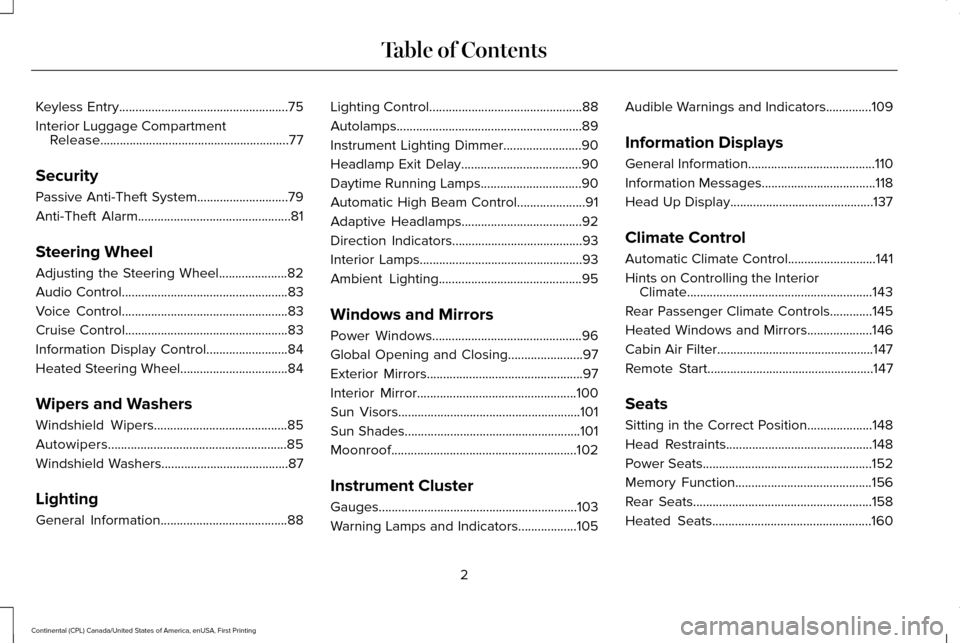
Keyless Entry....................................................75
Interior Luggage Compartment Release..........................................................77
Security
Passive Anti-Theft System............................79
Anti-Theft Alarm
...............................................81
Steering Wheel
Adjusting the Steering Wheel.....................82
Audio Control
...................................................83
Voice Control
...................................................83
Cruise Control..................................................83
Information Display Control.........................84
Heated Steering Wheel.................................84
Wipers and Washers
Windshield Wipers
.........................................85
Autowipers.......................................................85
Windshield Washers.......................................87
Lighting
General Information
.......................................88 Lighting Control...............................................88
Autolamps.........................................................89
Instrument Lighting Dimmer........................90
Headlamp Exit Delay.....................................90
Daytime Running Lamps...............................90
Automatic High Beam Control.....................91
Adaptive Headlamps
.....................................92
Direction Indicators
........................................93
Interior Lamps
..................................................93
Ambient Lighting............................................95
Windows and Mirrors
Power Windows
..............................................96
Global Opening and Closing.......................97
Exterior Mirrors
................................................97
Interior Mirror
.................................................100
Sun Visors
........................................................101
Sun Shades
......................................................101
Moonroof.........................................................102
Instrument Cluster
Gauges.............................................................103
Warning Lamps and Indicators..................105 Audible Warnings and Indicators
..............109
Information Displays
General Information
.......................................110
Information Messages
...................................118
Head Up Display............................................137
Climate Control
Automatic Climate Control...........................141
Hints on Controlling the Interior Climate.........................................................143
Rear Passenger Climate Controls.............145
Heated Windows and Mirrors....................146
Cabin Air Filter................................................147
Remote Start
...................................................147
Seats
Sitting in the Correct Position
....................148
Head Restraints.............................................148
Power Seats....................................................152
Memory Function
..........................................156
Rear Seats
.......................................................158
Heated Seats.................................................160
2
Continental (CPL) Canada/United States of America, enUSA, First Printing Table of Contents
Page 17 of 584
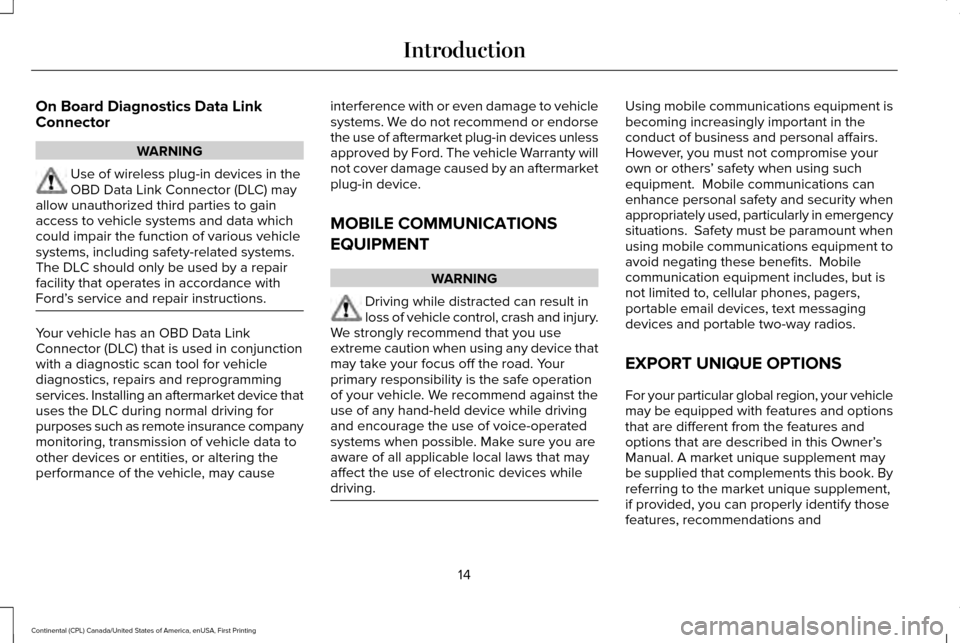
On Board Diagnostics Data Link
Connector
WARNING
Use of wireless plug-in devices in the
OBD Data Link Connector (DLC) may
allow unauthorized third parties to gain
access to vehicle systems and data which
could impair the function of various vehicle
systems, including safety-related systems.
The DLC should only be used by a repair
facility that operates in accordance with
Ford’ s service and repair instructions.Your vehicle has an OBD Data Link
Connector (DLC) that is used in conjunction
with a diagnostic scan tool for vehicle
diagnostics, repairs and reprogramming
services. Installing an aftermarket device that
uses the DLC during normal driving for
purposes such as remote insurance company
monitoring, transmission of vehicle data to
other devices or entities, or altering the
performance of the vehicle, may cause interference with or even damage to vehicle
systems. We do not recommend or endorse
the use of aftermarket plug-in devices unless
approved by Ford. The vehicle Warranty will
not cover damage caused by an aftermarket
plug-in device.
MOBILE COMMUNICATIONS
EQUIPMENT
WARNING
Driving while distracted can result in
loss of vehicle control, crash and injury.
We strongly recommend that you use
extreme caution when using any device that
may take your focus off the road. Your
primary responsibility is the safe operation
of your vehicle. We recommend against the
use of any hand-held device while driving
and encourage the use of voice-operated
systems when possible. Make sure you are
aware of all applicable local laws that may
affect the use of electronic devices while
driving. Using mobile communications equipment is
becoming increasingly important in the
conduct of business and personal affairs.
However, you must not compromise your
own or others
’ safety when using such
equipment. Mobile communications can
enhance personal safety and security when
appropriately used, particularly in emergency
situations. Safety must be paramount when
using mobile communications equipment to
avoid negating these benefits. Mobile
communication equipment includes, but is
not limited to, cellular phones, pagers,
portable email devices, text messaging
devices and portable two-way radios.
EXPORT UNIQUE OPTIONS
For your particular global region, your vehicle
may be equipped with features and options
that are different from the features and
options that are described in this Owner’ s
Manual. A market unique supplement may
be supplied that complements this book. By
referring to the market unique supplement,
if provided, you can properly identify those
features, recommendations and
14
Continental (CPL) Canada/United States of America, enUSA, First Printing Introduction
Page 20 of 584
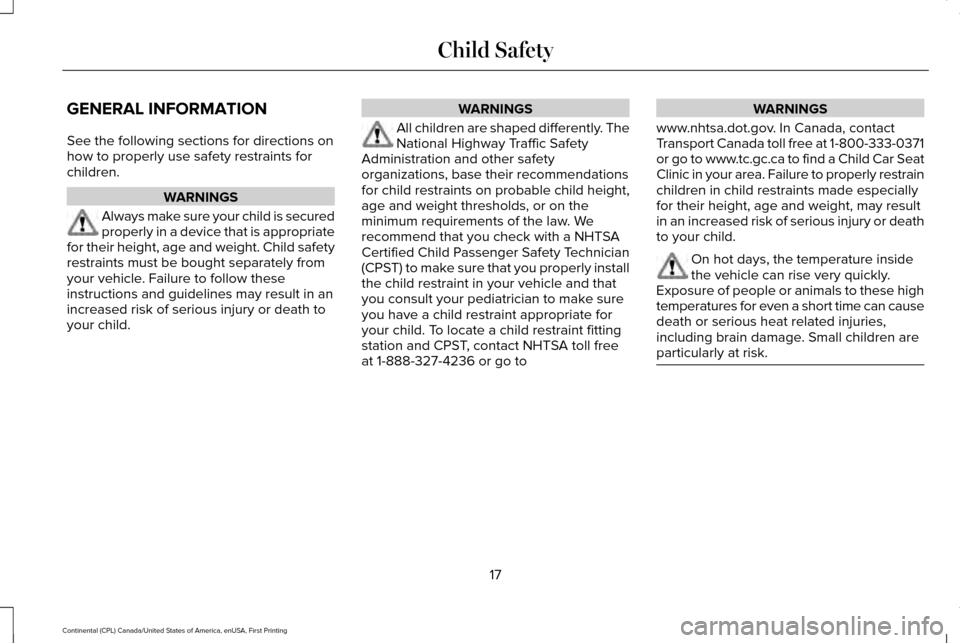
GENERAL INFORMATION
See the following sections for directions on
how to properly use safety restraints for
children.
WARNINGS
Always make sure your child is secured
properly in a device that is appropriate
for their height, age and weight. Child safety
restraints must be bought separately from
your vehicle. Failure to follow these
instructions and guidelines may result in an
increased risk of serious injury or death to
your child. WARNINGS
All children are shaped differently. The
National Highway Traffic Safety
Administration and other safety
organizations, base their recommendations
for child restraints on probable child height,
age and weight thresholds, or on the
minimum requirements of the law. We
recommend that you check with a NHTSA
Certified Child Passenger Safety Technician
(CPST) to make sure that you properly install
the child restraint in your vehicle and that
you consult your pediatrician to make sure
you have a child restraint appropriate for
your child. To locate a child restraint fitting
station and CPST, contact NHTSA toll free
at 1-888-327-4236 or go to WARNINGS
www.nhtsa.dot.gov. In Canada, contact
Transport Canada toll free at 1-800-333-0371
or go to www.tc.gc.ca to find a Child Car Seat
Clinic in your area. Failure to properly restrain
children in child restraints made especially
for their height, age and weight, may result
in an increased risk of serious injury or death
to your child. On hot days, the temperature inside
the vehicle can rise very quickly.
Exposure of people or animals to these high
temperatures for even a short time can cause
death or serious heat related injuries,
including brain damage. Small children are
particularly at risk. 17
Continental (CPL) Canada/United States of America, enUSA, First Printing Child Safety
Page 22 of 584
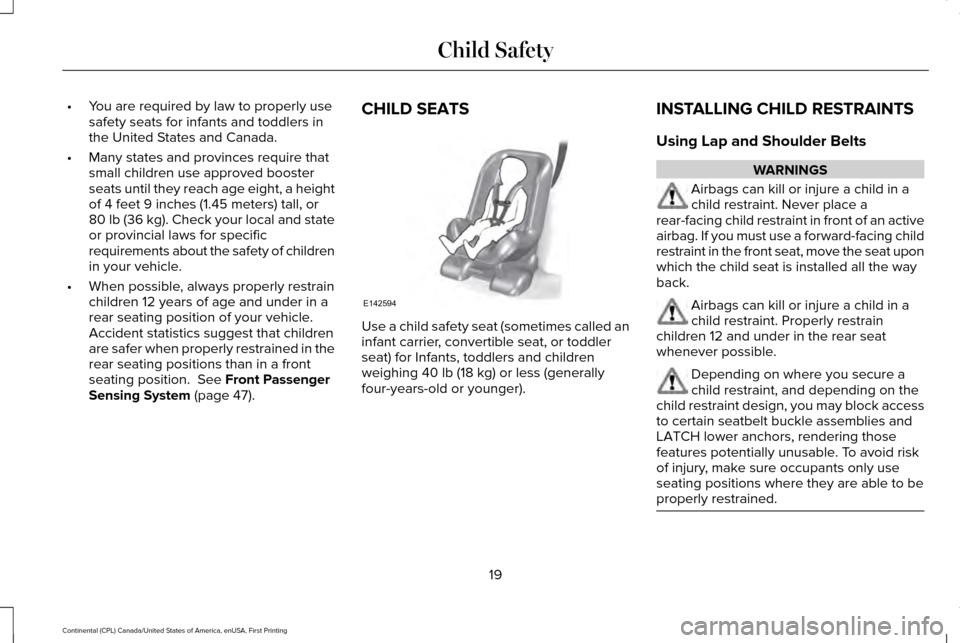
•
You are required by law to properly use
safety seats for infants and toddlers in
the United States and Canada.
• Many states and provinces require that
small children use approved booster
seats until they reach age eight, a height
of 4 feet 9 inches (1.45 meters) tall, or
80 lb (36 kg). Check your local and state
or provincial laws for specific
requirements about the safety of children
in your vehicle.
• When possible, always properly restrain
children 12 years of age and under in a
rear seating position of your vehicle.
Accident statistics suggest that children
are safer when properly restrained in the
rear seating positions than in a front
seating position.
See Front Passenger
Sensing System (page 47). CHILD SEATS
Use a child safety seat (sometimes called an
infant carrier, convertible seat, or toddler
seat) for Infants, toddlers and children
weighing
40 lb (18 kg) or less (generally
four-years-old or younger). INSTALLING CHILD RESTRAINTS
Using Lap and Shoulder Belts WARNINGS
Airbags can kill or injure a child in a
child restraint. Never place a
rear-facing child restraint in front of an active
airbag. If you must use a forward-facing child
restraint in the front seat, move the seat upon
which the child seat is installed all the way
back. Airbags can kill or injure a child in a
child restraint. Properly restrain
children 12 and under in the rear seat
whenever possible. Depending on where you secure a
child restraint, and depending on the
child restraint design, you may block access
to certain seatbelt buckle assemblies and
LATCH lower anchors, rendering those
features potentially unusable. To avoid risk
of injury, make sure occupants only use
seating positions where they are able to be
properly restrained. 19
Continental (CPL) Canada/United States of America, enUSA, First Printing Child SafetyE142594
Page 23 of 584
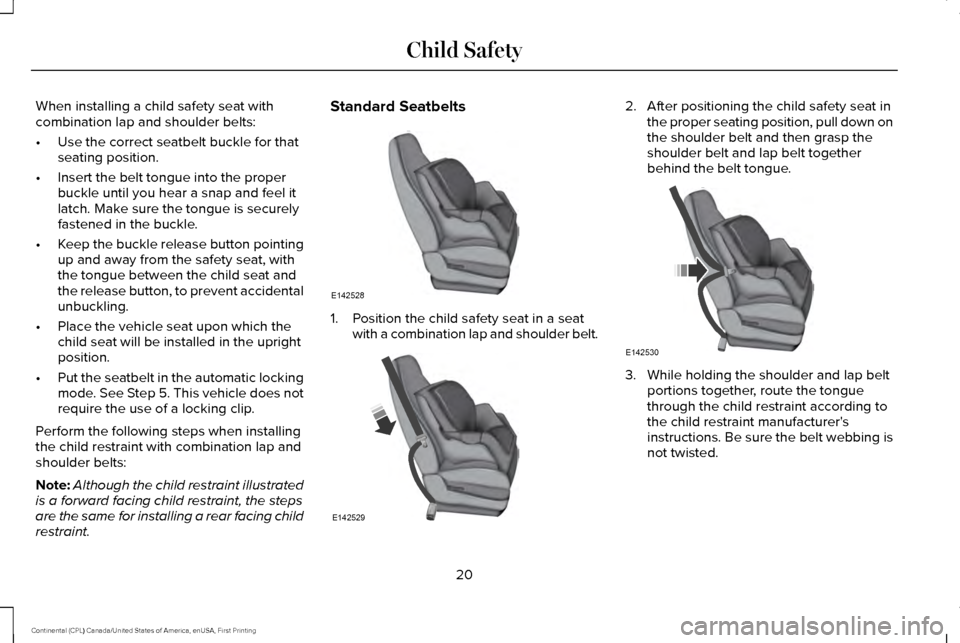
When installing a child safety seat with
combination lap and shoulder belts:
•
Use the correct seatbelt buckle for that
seating position.
• Insert the belt tongue into the proper
buckle until you hear a snap and feel it
latch. Make sure the tongue is securely
fastened in the buckle.
• Keep the buckle release button pointing
up and away from the safety seat, with
the tongue between the child seat and
the release button, to prevent accidental
unbuckling.
• Place the vehicle seat upon which the
child seat will be installed in the upright
position.
• Put the seatbelt in the automatic locking
mode. See Step 5. This vehicle does not
require the use of a locking clip.
Perform the following steps when installing
the child restraint with combination lap and
shoulder belts:
Note: Although the child restraint illustrated
is a forward facing child restraint, the steps
are the same for installing a rear facing child
restraint. Standard Seatbelts
1. Position the child safety seat in a seat
with a combination lap and shoulder belt. 2. After positioning the child safety seat in
the proper seating position, pull down on
the shoulder belt and then grasp the
shoulder belt and lap belt together
behind the belt tongue. 3. While holding the shoulder and lap belt
portions together, route the tongue
through the child restraint according to
the child restraint manufacturer's
instructions. Be sure the belt webbing is
not twisted.
20
Continental (CPL) Canada/United States of America, enUSA, First Printing Child SafetyE142528 E142529 E142530
Page 24 of 584

4. Insert the belt tongue into the proper
buckle (the buckle closest to the direction
the tongue is coming from) for that
seating position until you hear a snap and
feel the latch engage. Make sure the
tongue is latched securely by pulling on
it. 5. To put the retractor in the automatic
locking mode, grasp the shoulder portion
of the belt and pull downward until you
pull all of the belt out.
Note: The automatic locking mode is
available on the front passenger and rear
seats.
6. Allow the belt to retract to remove slack.
The belt clicks as it retracts to indicate it
is in the automatic locking mode. 7.
Try to pull the belt out of the retractor to
make sure the retractor is in the
automatic locking mode (you should not
be able to pull more belt out). If the
retractor is not locked, unbuckle the belt
and repeat Steps 5 and 6. 8. Remove remaining slack from the belt.
Force the seat down with extra weight,
for example, by pressing down or
kneeling on the child restraint while
pulling up on the shoulder belt in order
to force slack from the belt. This is
necessary to remove the remaining slack
that will exist once the extra weight of
21
Continental (CPL) Canada/United States of America, enUSA, First Printing Child SafetyE142531 E142875 E142533
Page 25 of 584
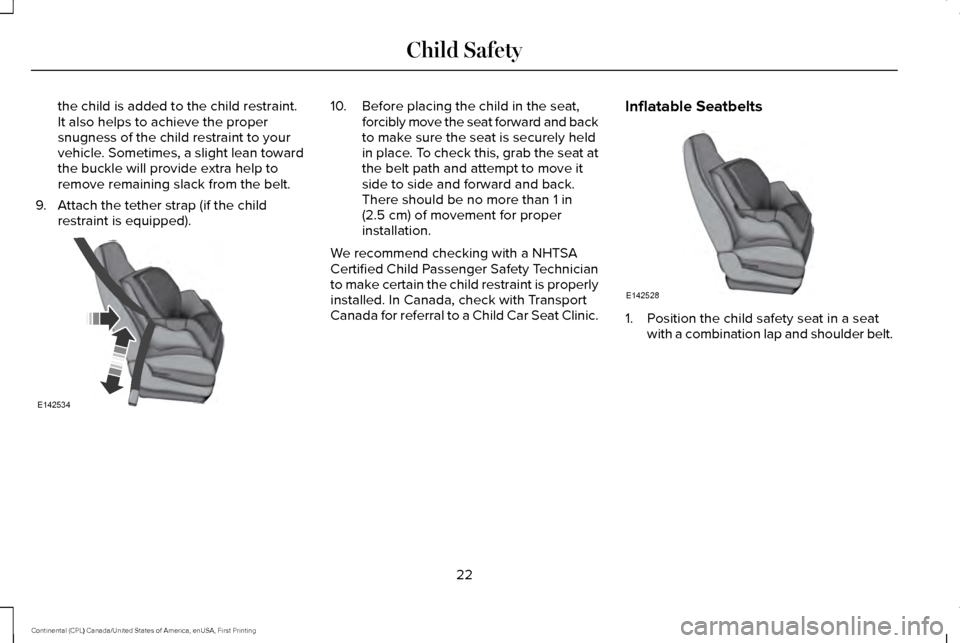
the child is added to the child restraint.
It also helps to achieve the proper
snugness of the child restraint to your
vehicle. Sometimes, a slight lean toward
the buckle will provide extra help to
remove remaining slack from the belt.
9. Attach the tether strap (if the child restraint is equipped). 10. Before placing the child in the seat,
forcibly move the seat forward and back
to make sure the seat is securely held
in place. To check this, grab the seat at
the belt path and attempt to move it
side to side and forward and back.
There should be no more than 1 in
(2.5 cm) of movement for proper
installation.
We recommend checking with a NHTSA
Certified Child Passenger Safety Technician
to make certain the child restraint is properly
installed. In Canada, check with Transport
Canada for referral to a Child Car Seat Clinic. Inflatable Seatbelts 1. Position the child safety seat in a seat
with a combination lap and shoulder belt.
22
Continental (CPL) Canada/United States of America, enUSA, First Printing Child SafetyE142534 E142528
Page 26 of 584
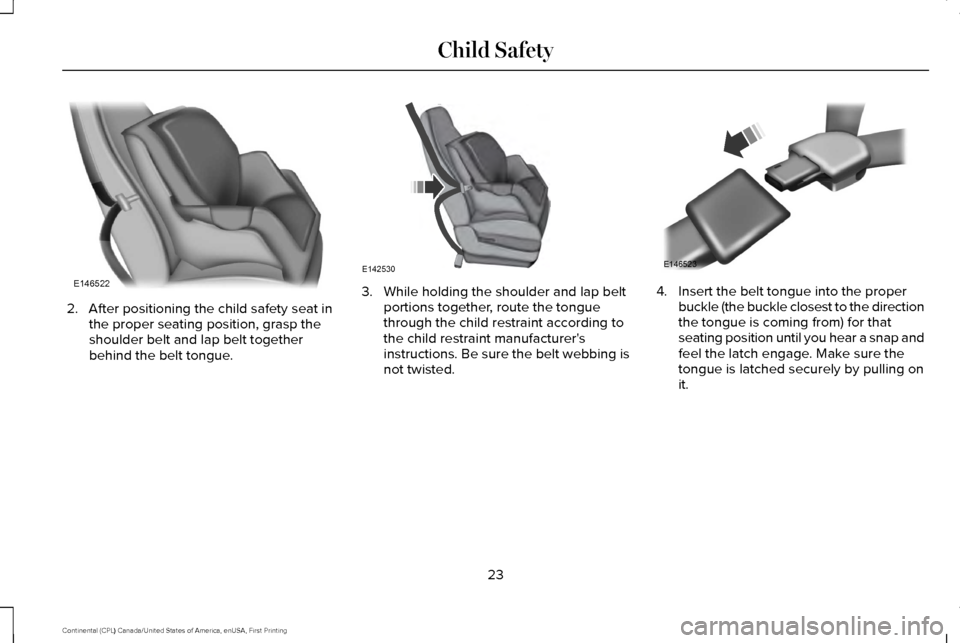
2. After positioning the child safety seat in
the proper seating position, grasp the
shoulder belt and lap belt together
behind the belt tongue. 3. While holding the shoulder and lap belt
portions together, route the tongue
through the child restraint according to
the child restraint manufacturer's
instructions. Be sure the belt webbing is
not twisted. 4. Insert the belt tongue into the proper
buckle (the buckle closest to the direction
the tongue is coming from) for that
seating position until you hear a snap and
feel the latch engage. Make sure the
tongue is latched securely by pulling on
it.
23
Continental (CPL) Canada/United States of America, enUSA, First Printing Child SafetyE146522 E142530 E146523
Page 28 of 584
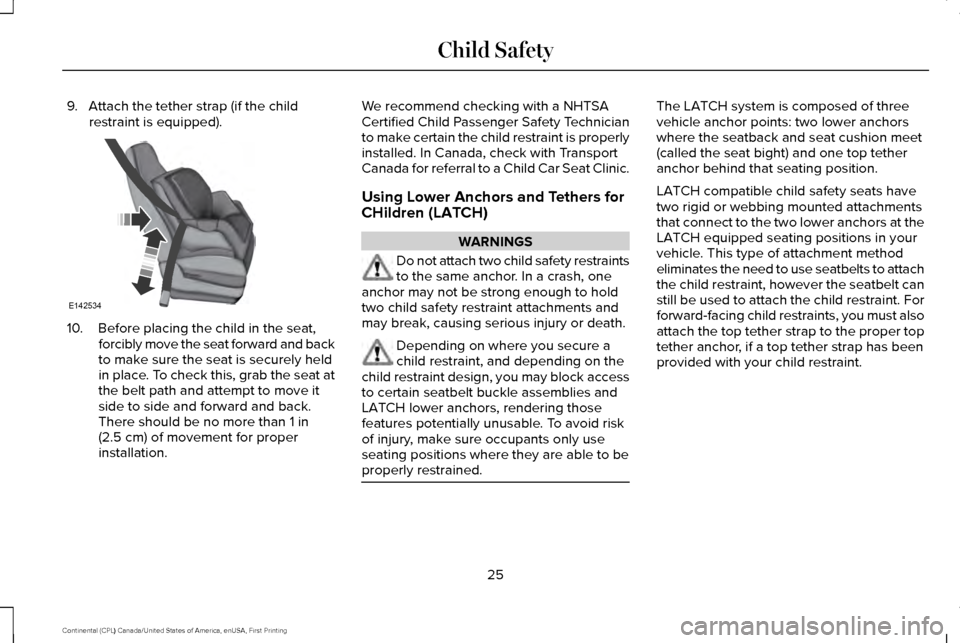
9. Attach the tether strap (if the child
restraint is equipped). 10. Before placing the child in the seat,
forcibly move the seat forward and back
to make sure the seat is securely held
in place. To check this, grab the seat at
the belt path and attempt to move it
side to side and forward and back.
There should be no more than 1 in
(2.5 cm) of movement for proper
installation. We recommend checking with a NHTSA
Certified Child Passenger Safety Technician
to make certain the child restraint is properly
installed. In Canada, check with Transport
Canada for referral to a Child Car Seat Clinic.
Using Lower Anchors and Tethers for
CHildren (LATCH) WARNINGS
Do not attach two child safety restraints
to the same anchor. In a crash, one
anchor may not be strong enough to hold
two child safety restraint attachments and
may break, causing serious injury or death. Depending on where you secure a
child restraint, and depending on the
child restraint design, you may block access
to certain seatbelt buckle assemblies and
LATCH lower anchors, rendering those
features potentially unusable. To avoid risk
of injury, make sure occupants only use
seating positions where they are able to be
properly restrained. The LATCH system is composed of three
vehicle anchor points: two lower anchors
where the seatback and seat cushion meet
(called the seat bight) and one top tether
anchor behind that seating position.
LATCH compatible child safety seats have
two rigid or webbing mounted attachments
that connect to the two lower anchors at the
LATCH equipped seating positions in your
vehicle. This type of attachment method
eliminates the need to use seatbelts to attach
the child restraint, however the seatbelt can
still be used to attach the child restraint. For
forward-facing child restraints, you must also
attach the top tether strap to the proper top
tether anchor, if a top tether strap has been
provided with your child restraint.
25
Continental (CPL) Canada/United States of America, enUSA, First Printing Child SafetyE142534
Page 29 of 584
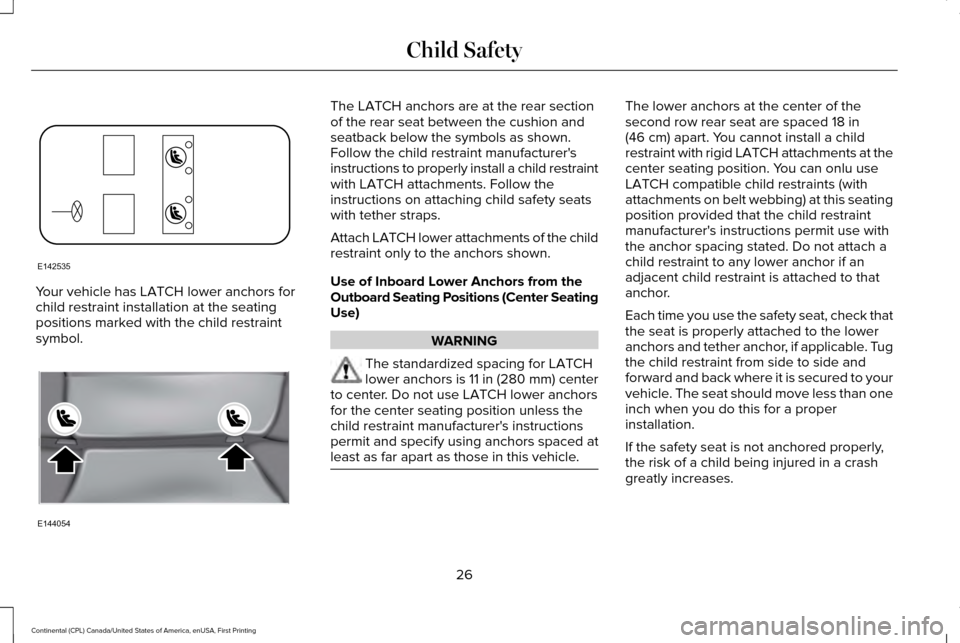
Your vehicle has LATCH lower anchors for
child restraint installation at the seating
positions marked with the child restraint
symbol. The LATCH anchors are at the rear section
of the rear seat between the cushion and
seatback below the symbols as shown.
Follow the child restraint manufacturer's
instructions to properly install a child restraint
with LATCH attachments. Follow the
instructions on attaching child safety seats
with tether straps.
Attach LATCH lower attachments of the child
restraint only to the anchors shown.
Use of Inboard Lower Anchors from the
Outboard Seating Positions (Center Seating
Use)
WARNING
The standardized spacing for LATCH
lower anchors is 11 in (280 mm) center
to center. Do not use LATCH lower anchors
for the center seating position unless the
child restraint manufacturer's instructions
permit and specify using anchors spaced at
least as far apart as those in this vehicle. The lower anchors at the center of the
second row rear seat are spaced 18 in
(46 cm) apart. You cannot install a child
restraint with rigid LATCH attachments at the
center seating position. You can onlu use
LATCH compatible child restraints (with
attachments on belt webbing) at this seating
position provided that the child restraint
manufacturer's instructions permit use with
the anchor spacing stated. Do not attach a
child restraint to any lower anchor if an
adjacent child restraint is attached to that
anchor.
Each time you use the safety seat, check that
the seat is properly attached to the lower
anchors and tether anchor, if applicable. Tug
the child restraint from side to side and
forward and back where it is secured to your
vehicle. The seat should move less than one
inch when you do this for a proper
installation.
If the safety seat is not anchored properly,
the risk of a child being injured in a crash
greatly increases.
26
Continental (CPL) Canada/United States of America, enUSA, First Printing Child SafetyE142535 E144054